Dinkel writes about a Lotus Europa TC
Discussion
Lotus Europa TC
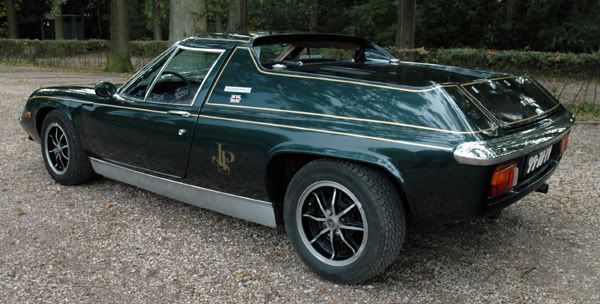
Sideview under the trees.
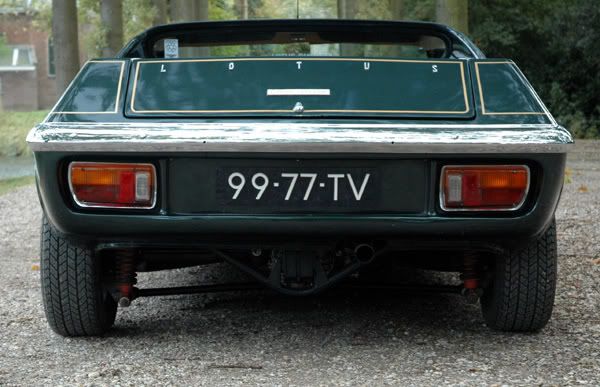
The boxxy back is like no other car's.

This car is in imaculate condition.
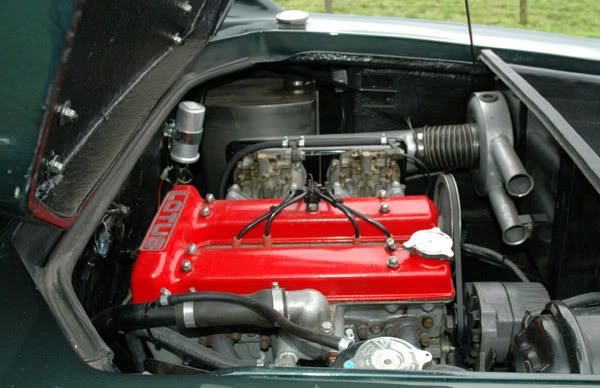
Lotus-Ford 1.6 TwinCam with two Dell'orto DHLA 40mm's gives 105 hp.
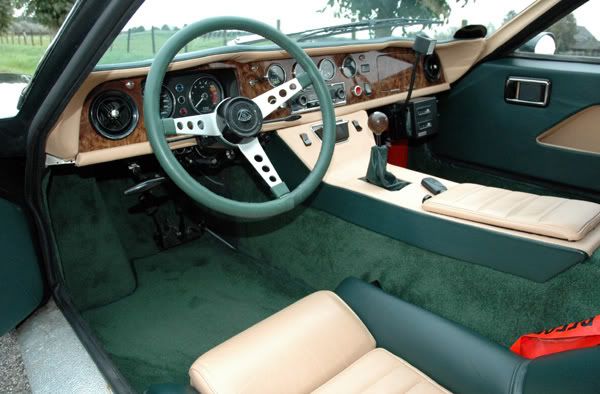
Classy interiour thanks to Bentley.

Economic use of space.
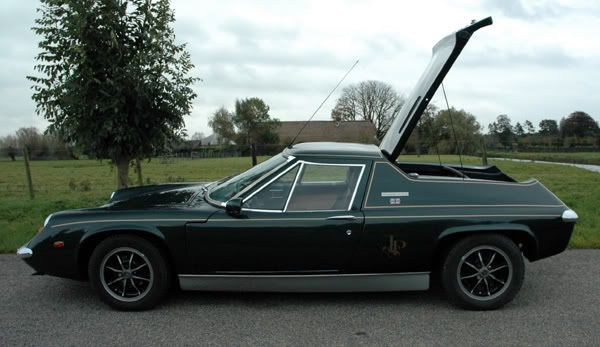
Classic silhouette with boot and engine entrance open.
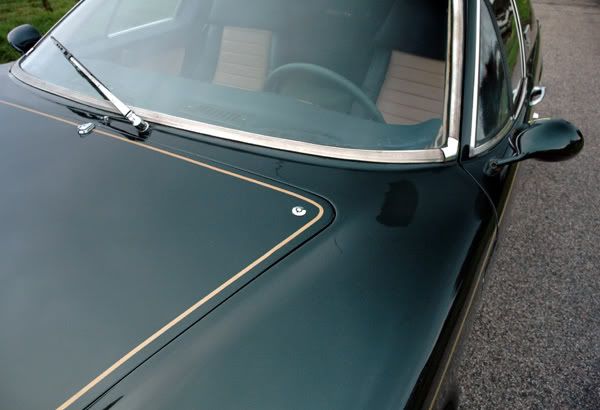
Front opens with three tiny locks.
Lotus Europa TC
On the list of cars I like and want to do a review about, I think only the Honda S850 has less horsepower than this 105 hp Lotus Europa TC. It doesn't look like much but bare in mind the configuration of only 740 kgs plus driver are likely to go places in a rapid way. With a bit of luck and craft this little British sports hits 60 in about 8 secs and steams on up to a nice 120. But that's for drivers with a death wish: this lightweight can lift her nose at speeds like that. There's a tiny front-spoiler trying to reduce just that. Still, impressive figures for a 1.6 mill powered car.
History
In line with 60s Lotus racing cars this Europe was among the first streetcars with an engine behind the seats and in front of the rear axle. At those days the choice of such a layout was limited to the Matra Djet and followed by the legendary and number 3 on my dreamcarlist: the '65 Lamborghini Miura. The development of the Europa started in 1963 with drawings by Ron Hickmann (of Work-mate fame) under the codename P5. Colin Chapmann wanted an equal simple and cheap sucessor for the Lotus 7. A team of skilled and experienced Lotusmen succeeded and since '66 the light and polyester bodied Type 47 powered by the 165 hp 1.6 Ford Cosworth twincam injection-engine raced in Sportscars Group 6. Only 55 were build. The '64 streetcar type 46 or Europa S1 used a pepped version of Renault's 1.6 engine from the frontwheel driven R16. With the reverse position of the 82 hp lump the housing of the 4-speed gearbox was attached to the inboard ends of the lower suspension links. About 650 were built. The smooth S1 is a real drivers car with an almost completely closed underside. By bonding body and frame it has a noticeable tighter drive compared to the S2. Those 'modified' and more comfortable Europa versions Type 54, and Type 65 for the US market, were produced from '68 to '70 (3615 pcs). The car described here is the Lotus-Ford-powered Type 74 or Europa TC (1971, 1580 pcs). By then the Renault gearbox in Lotus-housing was capable of taking 150 hp. Enough for the final and most popular Europa, the 126 hp racy Special Big Valve (3130 pcs). The choice of the Ford 1.6 was a forced one. Le Regie could've squeezed the same figures out of the R16 but used that engine in their Alpine, also a lightweight streetracer and thus a mere rival. Ironically TCBV owners have the option to swap the Lotus-Ford for the lighter Alpine R16 making their car even faster.
Racing Green JPS
This beautiful example is the only Dutch rolling TC. Owner Hans Ruiterkamp did restore with immense care for detail and he says it's now near finish. The only visible stain is a crack in the windscreen. The original and more frequent seen black and gold JPS livery is luvly but Hans' Racing Green car looks so much more distinct and gives this car a friendly appearance. You'd expect some of the agressiveness of Lotus' racing heritage in the looks of this TC. The low slung aerodynamic silhouette (Cd 0,29) and the handsome partial black 13" racing wheels would presume this indeed is a viscious little rotter. But peeping into the cockpit by opening the lightweight door by the Jaguar MK2 doorhandle, there's a surprise: this is a gentlemens club for two. I expected a spartan interior with only the essential needs for driving. Hans is chief mechanic at the Dutch Bentley dealers and used royal materials to compose a very classy inside. The dash is in Burr Walnut, the bucket seats are in green 'Spruce' and yellow 'Tangier' Connoly leather. My feet rest on green 'Connifer' 'Wilton' carpet. There's really not much space to move anything and I don't feel the need as I could sit here forever with a Cognac and sigar. The electric window is only a fingertip away.
Drive
Once calmed down from all this exuberance Hans explains the dials and buttons. The inboard computer behind the locker and the Tripmaster between my knees show this car is fit for whatever rally. This Lotus is modified to be the better car than it was 30 years ago but it's as original it needs to be for historic rally events. Simple black tumbler switches explain the no-nonsense character of this TC. The Triumph Spitfire steering column, the Volvo 440 electric windows (a standard feature on the S2, the 440s is a replacement / the S1 had fixed windows!) and the Arnage starter button make clear this is a multi-cultural chap. Now let's hit that red button. Just a little hesitation and the 1.6 behind us comes to live and runs a steady idle within secs. After only a few yards we get out of the car: the 2 inch electric fence lock is a too high obstacle! We get in, not an easy task BTW, Hans leaves his shoes behind and shifts into 1st. Just a little throttle and off we go for a saturday morning rural roads trip. It's instantly clear this Europe isn't driven as a streetracer. Hans loves his car and couresses it. But every now and then the right foot goes down to move the little basket the way it should.
The engine
On the better side of 4000 revs the TwinCam loosens up and hammers all the way up to 6.5k where the limiter comes in. Hans' limit is 5.5 and that's enough to keep most traffic at safe distance. There's no rawness, even at higher revs the two Dell'orto DHLA 40mm's keep the Ford's behaviour tidy. Only at running free before entering a corner a decent pop adds some extra flavour to the clean soundbyte. Boring? Not at all. It's just not that racy thingy I had in mind.
The enginebay pic shows the intake bending just in front of the boot, which is reasonable for such a small car. Funny detail is one of the cams driving the alternator. The upside down 'Lotus' embossed in the camcover I'll never understand. Lotus well considered the 180 degree position of the engine so IMO they'd've made a special Europa camcover.
Economic use of space
The pic shows the big boot, with the extra square space for the Lockheed servo assistance to replace the original Girlings. On both sides two big gastanks: 2 x 30 litres which I find pretty huge, provide for an amazing radius. One litre delivers about 12 kilometres average. That's 60 x 12 = 720 kilometres = 450 miles! Lotus Europa specialist Banks delivered a common modification for the fixed-length drive shafts which supports the structure. Colin Chapman's brain may've had some brilliant and economic solutions they're not always that smart. Banks made a supportive bridge that allows the shafts to run more freely. Three tiny locks give entrance to the radiator on the right and the spare wheel on the left. Separated by a space behind it is a neat space for a first aid kit and some tools. Standing in front of this just 107 cms low car I had to get on my knees to take a look at the plate. The original is replaced by punched steel figures on Bentley grating. An elegant solution that fits Hans' original and precise procedure.
Back home
Black clouds predict rain and we're hitting the road back home. What struck me was the lack of roadnoise. There's just the pleasant throb of the fourpot behind us and for that I kept the window open. There's no doubt this is an honest car. What is put in you'll get back. Cornering is snake-like without body-roll and with easy accuratesse. Strange but true the low position doesn't feel that low at all. And it's not only the luxurious cabin that gives me a very satisfied feeling: this racing car derrived Europa will get you a tankfull's distance in utter comfort.
At increasing speeds the bad road - bumpy tarmac - rocks the car. The TC's stiffness and tightness togheter with the though Koni's and 185 HR 13 tires offer a rigid ride with a modern touch. Tight fit seats keep you in place. Driving needs a third eye for speedbumps, bridges and potholes. A bang on the polyester ridges will set you back . . . The S2's body is removeable from the chassis while the S1's is not.
From all angles this Lotus has its own peculiar looks. The boxxy back with the E-type rearlights, the distinctive silhouette, the boatdeck roof, I can't think of a car that's so original and yet hasn't any epigones. Can you think of a car that does follow the Lotus Europa's lines?
Cheers, Albert
Dutch review and all pics at www.klassiekerrally.nl / Dinkels dreamcars
Edit: new pc urls in.

Sideview under the trees.

The boxxy back is like no other car's.

This car is in imaculate condition.

Lotus-Ford 1.6 TwinCam with two Dell'orto DHLA 40mm's gives 105 hp.

Classy interiour thanks to Bentley.

Economic use of space.

Classic silhouette with boot and engine entrance open.

Front opens with three tiny locks.
Lotus Europa TC
On the list of cars I like and want to do a review about, I think only the Honda S850 has less horsepower than this 105 hp Lotus Europa TC. It doesn't look like much but bare in mind the configuration of only 740 kgs plus driver are likely to go places in a rapid way. With a bit of luck and craft this little British sports hits 60 in about 8 secs and steams on up to a nice 120. But that's for drivers with a death wish: this lightweight can lift her nose at speeds like that. There's a tiny front-spoiler trying to reduce just that. Still, impressive figures for a 1.6 mill powered car.
History
In line with 60s Lotus racing cars this Europe was among the first streetcars with an engine behind the seats and in front of the rear axle. At those days the choice of such a layout was limited to the Matra Djet and followed by the legendary and number 3 on my dreamcarlist: the '65 Lamborghini Miura. The development of the Europa started in 1963 with drawings by Ron Hickmann (of Work-mate fame) under the codename P5. Colin Chapmann wanted an equal simple and cheap sucessor for the Lotus 7. A team of skilled and experienced Lotusmen succeeded and since '66 the light and polyester bodied Type 47 powered by the 165 hp 1.6 Ford Cosworth twincam injection-engine raced in Sportscars Group 6. Only 55 were build. The '64 streetcar type 46 or Europa S1 used a pepped version of Renault's 1.6 engine from the frontwheel driven R16. With the reverse position of the 82 hp lump the housing of the 4-speed gearbox was attached to the inboard ends of the lower suspension links. About 650 were built. The smooth S1 is a real drivers car with an almost completely closed underside. By bonding body and frame it has a noticeable tighter drive compared to the S2. Those 'modified' and more comfortable Europa versions Type 54, and Type 65 for the US market, were produced from '68 to '70 (3615 pcs). The car described here is the Lotus-Ford-powered Type 74 or Europa TC (1971, 1580 pcs). By then the Renault gearbox in Lotus-housing was capable of taking 150 hp. Enough for the final and most popular Europa, the 126 hp racy Special Big Valve (3130 pcs). The choice of the Ford 1.6 was a forced one. Le Regie could've squeezed the same figures out of the R16 but used that engine in their Alpine, also a lightweight streetracer and thus a mere rival. Ironically TCBV owners have the option to swap the Lotus-Ford for the lighter Alpine R16 making their car even faster.
Racing Green JPS
This beautiful example is the only Dutch rolling TC. Owner Hans Ruiterkamp did restore with immense care for detail and he says it's now near finish. The only visible stain is a crack in the windscreen. The original and more frequent seen black and gold JPS livery is luvly but Hans' Racing Green car looks so much more distinct and gives this car a friendly appearance. You'd expect some of the agressiveness of Lotus' racing heritage in the looks of this TC. The low slung aerodynamic silhouette (Cd 0,29) and the handsome partial black 13" racing wheels would presume this indeed is a viscious little rotter. But peeping into the cockpit by opening the lightweight door by the Jaguar MK2 doorhandle, there's a surprise: this is a gentlemens club for two. I expected a spartan interior with only the essential needs for driving. Hans is chief mechanic at the Dutch Bentley dealers and used royal materials to compose a very classy inside. The dash is in Burr Walnut, the bucket seats are in green 'Spruce' and yellow 'Tangier' Connoly leather. My feet rest on green 'Connifer' 'Wilton' carpet. There's really not much space to move anything and I don't feel the need as I could sit here forever with a Cognac and sigar. The electric window is only a fingertip away.
Drive
Once calmed down from all this exuberance Hans explains the dials and buttons. The inboard computer behind the locker and the Tripmaster between my knees show this car is fit for whatever rally. This Lotus is modified to be the better car than it was 30 years ago but it's as original it needs to be for historic rally events. Simple black tumbler switches explain the no-nonsense character of this TC. The Triumph Spitfire steering column, the Volvo 440 electric windows (a standard feature on the S2, the 440s is a replacement / the S1 had fixed windows!) and the Arnage starter button make clear this is a multi-cultural chap. Now let's hit that red button. Just a little hesitation and the 1.6 behind us comes to live and runs a steady idle within secs. After only a few yards we get out of the car: the 2 inch electric fence lock is a too high obstacle! We get in, not an easy task BTW, Hans leaves his shoes behind and shifts into 1st. Just a little throttle and off we go for a saturday morning rural roads trip. It's instantly clear this Europe isn't driven as a streetracer. Hans loves his car and couresses it. But every now and then the right foot goes down to move the little basket the way it should.
The engine
On the better side of 4000 revs the TwinCam loosens up and hammers all the way up to 6.5k where the limiter comes in. Hans' limit is 5.5 and that's enough to keep most traffic at safe distance. There's no rawness, even at higher revs the two Dell'orto DHLA 40mm's keep the Ford's behaviour tidy. Only at running free before entering a corner a decent pop adds some extra flavour to the clean soundbyte. Boring? Not at all. It's just not that racy thingy I had in mind.
The enginebay pic shows the intake bending just in front of the boot, which is reasonable for such a small car. Funny detail is one of the cams driving the alternator. The upside down 'Lotus' embossed in the camcover I'll never understand. Lotus well considered the 180 degree position of the engine so IMO they'd've made a special Europa camcover.
Economic use of space
The pic shows the big boot, with the extra square space for the Lockheed servo assistance to replace the original Girlings. On both sides two big gastanks: 2 x 30 litres which I find pretty huge, provide for an amazing radius. One litre delivers about 12 kilometres average. That's 60 x 12 = 720 kilometres = 450 miles! Lotus Europa specialist Banks delivered a common modification for the fixed-length drive shafts which supports the structure. Colin Chapman's brain may've had some brilliant and economic solutions they're not always that smart. Banks made a supportive bridge that allows the shafts to run more freely. Three tiny locks give entrance to the radiator on the right and the spare wheel on the left. Separated by a space behind it is a neat space for a first aid kit and some tools. Standing in front of this just 107 cms low car I had to get on my knees to take a look at the plate. The original is replaced by punched steel figures on Bentley grating. An elegant solution that fits Hans' original and precise procedure.
Back home
Black clouds predict rain and we're hitting the road back home. What struck me was the lack of roadnoise. There's just the pleasant throb of the fourpot behind us and for that I kept the window open. There's no doubt this is an honest car. What is put in you'll get back. Cornering is snake-like without body-roll and with easy accuratesse. Strange but true the low position doesn't feel that low at all. And it's not only the luxurious cabin that gives me a very satisfied feeling: this racing car derrived Europa will get you a tankfull's distance in utter comfort.
At increasing speeds the bad road - bumpy tarmac - rocks the car. The TC's stiffness and tightness togheter with the though Koni's and 185 HR 13 tires offer a rigid ride with a modern touch. Tight fit seats keep you in place. Driving needs a third eye for speedbumps, bridges and potholes. A bang on the polyester ridges will set you back . . . The S2's body is removeable from the chassis while the S1's is not.
From all angles this Lotus has its own peculiar looks. The boxxy back with the E-type rearlights, the distinctive silhouette, the boatdeck roof, I can't think of a car that's so original and yet hasn't any epigones. Can you think of a car that does follow the Lotus Europa's lines?
Cheers, Albert
Dutch review and all pics at www.klassiekerrally.nl / Dinkels dreamcars
Edit: new pc urls in.
Edited by dinkel on Tuesday 11th December 20:28
Europa TC in JPS color scheme a very fine car. The earlier models with the higher rear side buttresses were too bulky at the back but there's something about the TC shape that's absolutely balanced and "right". All round performance was astounding for its time in the classic Chapman mode. Many years ago I looked hard at trying to buy one and ended up with a Giugiaro Esprit instead. At that time decent Europas were already as rare as hens teeth and the few in good nick were seriously expensive for a very small and somewhat temperamental car.
Sits at the top of my list for all time design/performance alongside Ferrari 308/328.
I can think of few, if any, cars with the same side profile as Europa TC. Maserati Merak has hints of similarity with its triangular flying buttresses and was another unique design. The BMW M1 was also very tidy and I think both these may be by Giugiaro. A well designed mid-engined car should be immediately identifiable as such, unlike MGF and some well known germans.
Corvette engine/transaxle in the back of my next Lotus please! I'll take that in black & gold.
Sits at the top of my list for all time design/performance alongside Ferrari 308/328.
I can think of few, if any, cars with the same side profile as Europa TC. Maserati Merak has hints of similarity with its triangular flying buttresses and was another unique design. The BMW M1 was also very tidy and I think both these may be by Giugiaro. A well designed mid-engined car should be immediately identifiable as such, unlike MGF and some well known germans.
Corvette engine/transaxle in the back of my next Lotus please! I'll take that in black & gold.
5USA said:
. . . At that time decent Europas were already as rare as hens teeth and the few in good nick were seriously expensive for a very small and somewhat temperamental car. . .
The one I reviewed is almost perfect. And the only Dutch running TC!
I guess in the UK there must be lots?
5USA said:
Maserati Merak has hints of similarity with its triangular flying buttresses and was another unique design. The BMW M1 was also very tidy and I think both these may be by Giugiaro.
Indeed, both by Giugiaro.
dinkel said:
I guess in the UK there must be lots?
Don't see them as often as Elans, though they made about as many.
Andrew Noakes said:It's great to see the immaculate TC reviewed by Dinkel although cars in that condition may be very rare indeed. It's one of life's mysteries where all the Europas went as more than 9,000 were built. [Compare about 12,000 Elans, 5,000 Plus 2s and 10,000 Esprits of all models] A nice Lotus holds its value well but tatty examples, especially of the less sought after models, rapidly pass the point where restoration costs more than the value of the finished car. A significant number of Europas may have found their way to the scrap-yard at a young age, helped along by relative fragility. I think it's only from the S3 Esprit and Excel that reasonable mechanical integrity could be taken for granted.
Don't see them as often as Elans, though they made about as many.
In contrast to these early Lotus build numbers Chevrolet has consistently built around 30,000 Corvettes EACH YEAR! That volume of sales has supported an enthusiastic parts and restoration business and a good proportion of all Corvettes built are still running. Mazda has also shifted a shed-load of MX5s in the last 15 years. No surprise Lotus would like to get a slice of that pie with the latest federal Elise!
The Europa's a gorgeous car, bearing in mind it was a contemporary of the Ferrari Dino and Lamborghini Miura. A properly-driven Europa could dispatch a Dino easily, and with a GKN V8 conversion, it'll snap at the heels of the Miura too.
Pity I'll never get the chance to do either. I tried to get into a Europa a couple of years ago and no matter what I do I just can't fit in it. I tried to get in arse first only to find the door wasn't big enough to allow my legs in. Then I tried getting in feet first only to find my left foot filled the footwell diagonally, I couldn't get my knee round the wheel and my legs were literally too long to let me sit down. A massive disappointment.
Strangely enough though, I fit really easily into an Elan of the same era. Weird.
Pity I'll never get the chance to do either. I tried to get into a Europa a couple of years ago and no matter what I do I just can't fit in it. I tried to get in arse first only to find the door wasn't big enough to allow my legs in. Then I tried getting in feet first only to find my left foot filled the footwell diagonally, I couldn't get my knee round the wheel and my legs were literally too long to let me sit down. A massive disappointment.
Strangely enough though, I fit really easily into an Elan of the same era. Weird.
Andrew Noakes said:
I guess in the UK there must be lots?
Don't see them as often as Elans, though they made about as many.
Probably because most Europas were made for export only - the S1 and S2 weren't even offered for sale in Britain. They were aimed primarily at the Alfa Romeo Giulia GTV market, offering GT40/Dino/Miura-style sophistication to the 'average' sports car buyer. I think initially Lotus saw little commercial potential for it in Britain as the Elan offered a better blend of practicality and performance for drivers used to MGs and Triumphs, even though the Elan was nearly E-Type money.
Kentish said:
Funny how some shapes become graceful over the years.
Back in the late '80s and early '90s this was regarded by many as an ugly car.
Personally, I have always very much liked it.
Time really does mellow things.
Consider the popular reactions to the Jaguar XJS, for example. For decades people complained because it didn't have a classic Jaguar grille and because it had rear buttresses.
Nowadays people just appreciate what a graceful design it is. True, it doesn't look like a Jaguar (IMO if you look at this and the Maserati Kyalami it looks like the Indy replacement and the XJ40 Coupe prototype drawings got lost in the post and ended up in the wrong letterboxes - picture a Trident in the XJS grille and it has hints of Mistral about it), but there's no denying it's a capable GT from the classic era.
Good review Dinkel, only bit I noticed is that the cam doesn't drive the water pump, but the alternator. The S2 versions with the renault engine drove the water pump from the cam as well (I think).
Twincam16 do you have any more info on this GKN V8 conversion you mentioned? As far as I know it was a single bespoke car that was rather more involved than a simple conversion (new frame from firewall back, body lenghtened a few inches between wheels, etc).
Gary
Twincam16 do you have any more info on this GKN V8 conversion you mentioned? As far as I know it was a single bespoke car that was rather more involved than a simple conversion (new frame from firewall back, body lenghtened a few inches between wheels, etc).
Gary
gary_tholl said:
Twincam16 do you have any more info on this GKN V8 conversion you mentioned? As far as I know it was a single bespoke car that was rather more involved than a simple conversion (new frame from firewall back, body lenghtened a few inches between wheels, etc).
Gary
I'm going off information in a book of mine - Lotus, by Roy Bacon. According to him there doesn't seem to be as much radical reworking as you suggest - just the installation of the V8, some chassis strengthening, a new gearbox and better engine bay ventilation. I know GKN only made one as a feasibility study for Lotus to build a Miura rival on the cheap with a Rover V8.
A PHer told me (can't remember who), that it had been restored and bored out to 4.4 litres and now does well over 180 mph.
Banks Europa specialists do similar conversions nowadays too - everything from a Vauxhall 'red-top' to a V8, plus a redesigned dashboard and pedals. I'd love to drive one - if I could fit!
I think you`re talking about GKN 47D which my father drove several times when it was current. My understanding is that it was a modified Type 47 rather than a Europa and it was very much a bespoke one-off hot rod. Interestingly GKN also had a Mk1 Capri with a Gurney Weslake V8 fitted - apparently this was very good at wheelies!
p.s. If it was a pukka 47 then it would have been quicker than a Miura anyway!
p.s. If it was a pukka 47 then it would have been quicker than a Miura anyway!
The GKN 47D was a one off.
http://postdiluvian.org/~seven/pics/cars/47d/might.h
From what I have heard through europa groups, Richard at banks doesn't do a V8 conversion. He did have pics of one, but he doesn't like the thought of one for some reason and so has never built one.
There have been a few V8 Europas built that didn't go to the lenghts that GKN did, and I intend to do one with a Lotus V8 someday, but the (one and only) GKN 47D, which is in the Northeastern US and was only recently rebuilt, was a huge job. I'm pretty sure it hasn't been 'raced' or anything like that, as apparently the owner is quiet shy and retiring. This is just info I've picked up off of the yahoo groups Europa list, which has members that know the owner.
Gary
http://postdiluvian.org/~seven/pics/cars/47d/might.h
From what I have heard through europa groups, Richard at banks doesn't do a V8 conversion. He did have pics of one, but he doesn't like the thought of one for some reason and so has never built one.
There have been a few V8 Europas built that didn't go to the lenghts that GKN did, and I intend to do one with a Lotus V8 someday, but the (one and only) GKN 47D, which is in the Northeastern US and was only recently rebuilt, was a huge job. I'm pretty sure it hasn't been 'raced' or anything like that, as apparently the owner is quiet shy and retiring. This is just info I've picked up off of the yahoo groups Europa list, which has members that know the owner.
Gary
Dinkel
Nice article
Here's my type 65 i restored and have owned for 9yrs, 36k original mileage and i love it. When the new europa comes out 2006, i think there may some renewed interest in the original ones
(pic)www.pistonheads.com/pics//members/24506-car.jpg?nocache=832(/pic)
Nice article

Here's my type 65 i restored and have owned for 9yrs, 36k original mileage and i love it. When the new europa comes out 2006, i think there may some renewed interest in the original ones
(pic)www.pistonheads.com/pics//members/24506-car.jpg?nocache=832(/pic)
Taken from Carlos Ghys website:
http://www.carlosghys.be/
“We arrived at Silverstone on the Tuesday before the 1973 British GP.
Ronnie Peterson and Emerson Fittipaldi were giving rides to journalists and guests in a lotus Europa and an Elan. I had Ronnie’s deerstalker picture with me and one of Fittipaldi’s wife, Maria-Helena. She was sitting on the pit guard rail, so I showed her the photo and we got talking.
Then Peterson stopped and asked if anyone wanted a ride. There was no-one around, so I put my hand up. The door was closed and I had fastened my belts when there was a knock on the window. It was Lotus team manager Peter Warr asking if I was Press. When I admitted I wasn’t, he said, “Out!”. But Fittipaldi’s wife convinced him to let me have a ride.
Those two laps with Ronnie was an experience I will never forget”…
I bet! Lucky git . . .
Source: Motorsport Magazine
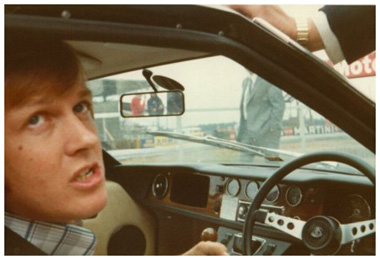
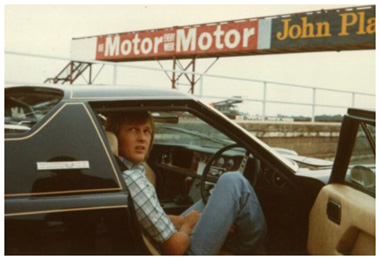
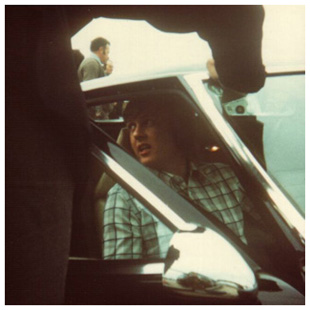
Ronnie Peterson:“anyone wants a ride”
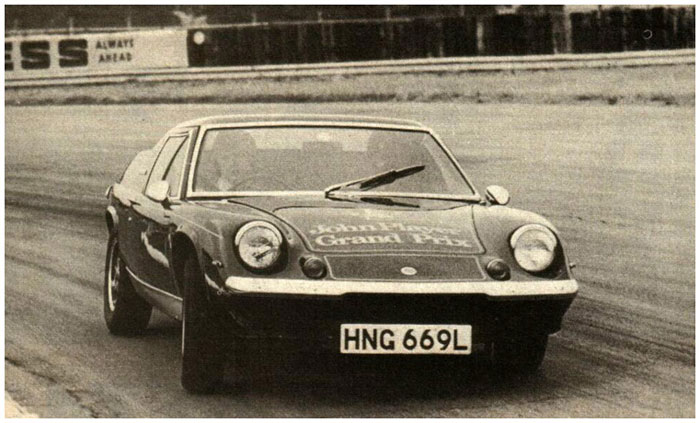
Ronnie Peterson hurrying the Lotus Europe through Woodcote corner
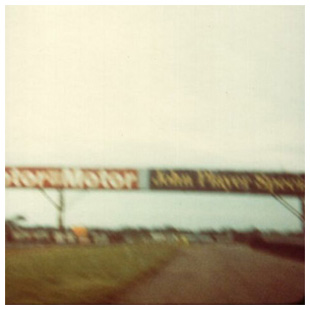
View from the passenger’s seat, coming out of Woodcote corner.
This is the result of a small camera, high speed and thrilling emotions…
This is why I love Facebook.
Anyone knows where the car is now?
http://www.carlosghys.be/
“We arrived at Silverstone on the Tuesday before the 1973 British GP.
Ronnie Peterson and Emerson Fittipaldi were giving rides to journalists and guests in a lotus Europa and an Elan. I had Ronnie’s deerstalker picture with me and one of Fittipaldi’s wife, Maria-Helena. She was sitting on the pit guard rail, so I showed her the photo and we got talking.
Then Peterson stopped and asked if anyone wanted a ride. There was no-one around, so I put my hand up. The door was closed and I had fastened my belts when there was a knock on the window. It was Lotus team manager Peter Warr asking if I was Press. When I admitted I wasn’t, he said, “Out!”. But Fittipaldi’s wife convinced him to let me have a ride.
Those two laps with Ronnie was an experience I will never forget”…
I bet! Lucky git . . .
Source: Motorsport Magazine



Ronnie Peterson:“anyone wants a ride”

Ronnie Peterson hurrying the Lotus Europe through Woodcote corner

View from the passenger’s seat, coming out of Woodcote corner.
This is the result of a small camera, high speed and thrilling emotions…
This is why I love Facebook.
Anyone knows where the car is now?
I seem to recall road tests of the era put the 0-60 in the 6's and the Elan maybe even in the 5's albeit with criticism of "wind-up in the rubber doughnuts", a phrase I have always remembered.
As a lad, around 1974-5, I went and sat in a lime-green Europa and fell in love with it - the thin seats, the legs-out driving position, it was a true no-compromise car and I loved it. When I test drove an Elise, that raw thrill seemed to be missing but it may be my age at the time that ade it so much more memorable.
As a lad, around 1974-5, I went and sat in a lime-green Europa and fell in love with it - the thin seats, the legs-out driving position, it was a true no-compromise car and I loved it. When I test drove an Elise, that raw thrill seemed to be missing but it may be my age at the time that ade it so much more memorable.
Gassing Station | Classic Cars and Yesterday's Heroes | Top of Page | What's New | My Stuff




 When the 'old' Banks site was in the air a 302 cid V8 Silverish Europa was displayed somewhere in their galleries . . . Mental!
When the 'old' Banks site was in the air a 302 cid V8 Silverish Europa was displayed somewhere in their galleries . . . Mental!